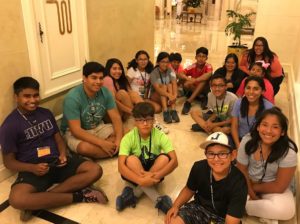Traveling to Your Child’s Country of Birth: Benefits and Complexities
For many years, families who have adopted internationally have embarked on heritage journeys with their children, raising important questions about the appropriateness of children visiting their countries of origin while they are young.
As founder of The Ties Program, I’ve spent almost thirty years traveling with thousands of families as they explore their child’s country of birth. As I observe and listen to the adoptees, and witness the profound changes a homeland journey brings, these issues are always front and center for me.
While I obviously believe in the homeland journey experience, I don’t approach the subject with rose-colored glasses. There are things, hard things families need to consider. I’ll discuss both in this article.
The Benefits:
Adoptees who travel on homeland journeys are bursting at the seams with positives. “Words can’t describe how wonderful this has been for me!” responded Ashley Husby, an adoptee visiting Chile for the first time since being adopted. Ashley’s reaction is shared by nearly every adoptee who has ever traveled with our programs.
Identity-Building: Most internationally adoptees struggle with a sense of dual identity—being American and Korean, or being American, but also Guatemalan. A heritage trip does not define them as one or the other—in fact, a heritage trip tends to blur the lines, and gets adoptees thinking about their complex relationship to “homeland,” “home,” and “self.”
Through Andrew Bartlett, as he reflects on his voyage of discovery, you can hear this process: “Ever since I was young, I knew this question of identity would have to be answered someday. As I seek to discover who I am and who I will become as an adult, I needed to rediscover the past. After visiting Korea, I now realize that I am neither Korean nor American but a unique mixture of both countries and cultures.”
Pride: “The people with whom I share my heritage are warm, wonderful, genuine people.” This is perhaps the single most important message an adoptee can receive during a homeland journey. Adoptees of any age can receive it, and most are eager to hear it, although they may not know it themselves.
Elizabeth McIntosh fell clearly into the last category. When her parents adopted her, they brought home a Cambodian flag that was neatly folded on the coffee table and dusted around for a decade, garnering no interest from Elizabeth. Then ten-year-old Elizabeth traveled to Cambodia. Upon her return, Elizabeth grabbed the flag and exclaimed, “Let’s hang this right now!” So, in the wee hours of the morning, Elizabeth enthusiastically hoisted the flag high over her house in Memphis. As her mother said, “That moment speaks to the profound impact the trip had on Elizabeth.”
Elizabeth had claimed her birth country as a significant part of her and was bursting with pride to share it with the world.
 Belonging: It’s a basic human need. We all crave it, and adoptees find it among their peers as they visit their birth country. The importance of adoptees sharing this experience with other adoptees cannot be overstated. Their comfort level with each other is evident from the start.
Belonging: It’s a basic human need. We all crave it, and adoptees find it among their peers as they visit their birth country. The importance of adoptees sharing this experience with other adoptees cannot be overstated. Their comfort level with each other is evident from the start.
Fifteen-year-old Nicholas Brunson summed it up, saying, “We came here as strangers and left as a family.” The adoptees realize they have a community they can be part of if they choose—other international adoptees who share their experience of having a foot in two different worlds. We often hear, “Wow! I am not alone. I have made friends that will last a lifetime.”
Validation, Contextualization, and Settling: Being there is validating. For many adoptees, their very existence is made more real by experiences like seeing a file or an intake chart, meeting caregivers, and visiting people and places significant to the their adoption. Being there provides context. On a homeland journey, adoptees (even young ones) begin to process social stigma, government policies, poverty, and individual birth family circumstances—all things that answer the biggest question they have: WHY?
Being there is settling. The end result is that most adoptees ultimately find the experience settling. “For the first time in my life, I felt complete and at peace with who I am” is a sentiment we hear often.
So, with all that good news, what’s the downside?
The Complexities
No journey as emotionally charged as this one can come without complexities that adoptees and their families need to carefully consider.
Preparation: Cultural, emotional, and logistical preparations are essential. We spend a great deal of time talking with families about the need for deliberate preparation.
Here are some ideas:
- Encourage adoptees to dream within their comfort zone about the things they would like to do in their birth country; don’t discourage anything.
- Adoptees and their families need to be deliberate about exposing themselves to poverty, discussing it and disassociating it with people of color. Without that step, adoptees may arrive in their birth country and decide the only place poverty is an issue is in their birth country. The pain associated with that goes to the core of an adoptee.
- Each family member’s coping mechanisms need to be explored, enhanced and incorporated into the journey. There is a LOT to process. Awareness and use of coping mechanisms takes dedicated time and energy, but helps participants immensely on this journey.
- Adoptees and their families need to be knowledgeable about cultural similarities and differences. Without this step, serious misunderstandings can arise that feel very hurtful to the adoptee.
No one knows where the road leads…. Until we are living the moment, it is impossible to know what will unfold. There are times when a file is opened, for example, and information is shared that is inconsistent with what the family was told upon adoption. Sometimes there is a change in the child’s birth date, or perhaps a different spelling of a name, or the notation of siblings. Sometimes the new information goes well beyond that. Even minor changes tend to be major changes for adoptees because changing their story can be deeply unsettling.
Sometimes the road goes in a different direction all together—families sometimes find the orphanage, or the adoptee’s file no longer exists, or the keeper of the file is unwilling to share information. Occasionally, caregivers or others who are scheduled to meet the adoptee don’t show up for a variety of reasons, all of them very difficult for an adoptee to understand.
 Sometimes a lot more information suddenly becomes available. Many years ago, a fourteen-year-old girl and her family were traveling with Korean Ties. Her file read that she had been found on the doorstep of an orphanage, nothing more. The family visited the orphanage expecting simply to be in the place their daughter lived prior to her adoption–profoundly significant all on its own. When they arrived, a worker opened her file and said, “What was in your records was incorrect. In fact, your birth father brought you here, and he still lives here. Would you like me to call him?”
Sometimes a lot more information suddenly becomes available. Many years ago, a fourteen-year-old girl and her family were traveling with Korean Ties. Her file read that she had been found on the doorstep of an orphanage, nothing more. The family visited the orphanage expecting simply to be in the place their daughter lived prior to her adoption–profoundly significant all on its own. When they arrived, a worker opened her file and said, “What was in your records was incorrect. In fact, your birth father brought you here, and he still lives here. Would you like me to call him?”
You can imagine the excitement and anxiety in the room. This story is uncommon, but not unique. One of the hardest things we do is to try to help adoptees and families understand that they may learn nothing new, or everything they have ever wondered about. This level of uncertainty can be very hard for adoptees and parents to deal with.
Search issues: Many adoptees are not ready (and may never be ready) to do a birth parent search, but are still in search of many important things like culture, language, social norms, belonging and so forth. When parents are involved in searching, it is is complex because most parents are trying to do the right thing, but unsure what the right thing is. Some parents don’t want to take on a role they feel should be their child’s, but on the other hand, they don’t want the trail to grow cold. They may want to gather as much information as they can so if and when their child has an interest, they can provide as much help as possible. They worry, “If I don’t, will my child be angry that I didn’t try when I had the chance? Or, if I do, will my child be angry that I opened a door they didn’t want to go through?” These are sensitive issues we help each family work through.
Determining the right time to travel: Parents wonder: do we wait until our child shows interest? Until the child is old enough to appreciate and remember the journey? Or do we exercise our parental prerogative to make decisions we believe are in the best interest of our children? As one workshop participant put it: “Should we treat it like eating vegetables?” These are complicated questions.
Over the years, adoptees traveling with Ties have been as young as 4 and as old as 57. We’ve found adoptees of all ages have done GREAT–getting out of the experience what they needed to at the age they traveled.
If you are a parent trying to determine the best age, I encourage you to ask these questions:
- At what age would I like my child to know that the people with whom she shares her heritage are warm, wonderful, genuine people?
- At what age would I like to give my child the experiences and tools she may need to form a healthy identity, integrating the culture she was born into and the culture she lives in?
The answers to these questions will be different for every family and every adoptee.
A homeland journey is wonderful, but complex. As you are considering whether or when to embark on this important life experience in adoption, thinking through the complexities is essential to creating a positive experience that builds a strong sense of self, community, and connection.
By Becca Piper, Founder and Co-Director of The Ties Program
